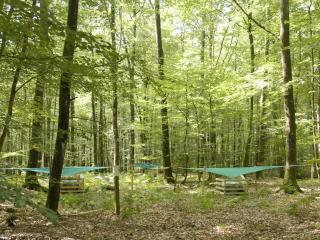Quantitative and Evolutionary Ecology of Communities Group
Members

Doctorante
UCBL

Professeure des universités
VetAgro-Sup
Tel: 33 04 72 43 27 56

Directeur de recherche
CNRS
Tel: 33 04 72 43 27 57

Doctorant
UCBL
Tel: 04 72 44 81 42

Doctorant
CNRS
Tel: 04 72 44 81 42
Doctorant
VetAgro-Sup

Maître de conférences
UCBL
Tel: 04 72 44 81 42
Doctorant
UCBL


Professeur des universités
UCBL
Tel: 33 04 72 43 27 56

Professeur des universités
UCBL

Directeur de recherche
CNRS
Tel: 33 04 72 43 27 56

Maîtresse de conférences
UCBL
Tel: 33 04 72 43 29 02
Maître de conférences
UCBL
Tel: 33 04 72 43 29 02

Our research activities, focused on interspecific interactions (community ecology), aim to better understand the ecological and evolutionary processes structuring species assemblages and biodiversity at different temporal and spatial scales. Our team addresses these major issues using contrasting biological models (communities of large African mammals, insects, microbiota, plants) from 3 complementary angles:
- Our work is strongly anchored in the conceptual framework of evolutionary biology by studying (i) the diversity of adaptive responses implemented by organisms to selective pressures in their environment, (ii) their consequences on population demography and ultimately (iii) the dynamics and composition of species communities.
- Our research is closely linked to societal issues of biodiversity conservation and management by integrating both the functioning of socio-ecological systems and the context of climate change. We conduct experimental studies, manage and ensure the long-term monitoring of several community observation networks.
- Methodological issues also occupy a central place in our team, with the development of new tools for statistical processing and modeling of ecological data. This activity leads to the development of methods and software that we develop and distribute freely.
Research programs

Functioning of African savanna communities
The Hwange LTSER (Long-Term Socio-Ecological Research site in Zimbabwe hosts a long-term interdisciplinary research program that focuses on the functioning of plant and animal communities within the Hwange National Park and the interactions between this protected area and humans living in its periphery. Based on this program, three axes are developed: (1) studying the population dynamics of elephants, exploring their impact and that of management policies on the socio-ecosystem functioning; (2) Understanding the extent to which interactions within and between trophic levels are sensitive to management actions (e.g. sport hunting, water management) and climate change; (3) Decoding human ecology and human-wildlife coexistence mechanisms towards integrated conservation and sustainable functioning of the socio-ecosystem. This research is complemented by more recent works in the Hluhluwe-iMfolozi Park and in the Madikwe reserve in South Africa, which focus on the role of environmental conditions on the hunting success of large African carnivores. We work in close collaboration with the IRL (International Research Lab) Rehabs.
Involved group members : Alice Bernard, Laura Lacomme, Aïssa Morin, Lisa Nicvert, Elie Pedarros, Yolan Richard, Marion Valeix*

Masting and the community dynamics of seed consumers
Masting is a reproductive strategy often encountered in perennial plants, characterized by fructifications highly fluctuating in time and being synchronized at the population level. The seeds produced that way constitute a pulsed resource with a strong impact on the eco-evolutionary dynamics of seed-consuming communities and forest regeneration. Our lack of knowledge of this system still impedes our understanding of the dynamics of temperate forest ecosystems and its future in the context of climate change. Our work carried out on oak forests aims to better understand (i) the proximal causes of masting, (ii) the mechanisms underlying the coexistence of species competing for such highly fluctuating resource and (iii) the co-evolution of consumer exploitation strategies for the fluctuating resource and forest tree fruiting strategies. On the basis of the results obtained, scenarii will be proposed on the future of forest regeneration under climate change, that may serve forest management.
Involved group members : Marie-Claude Bel-Venner*, Emilie Fleurot, Léa Keurinck, Jean Lobry, Samuel Venner

The spread of antibiotic resistance genes in bacteria
Antibiotic resistance is recognized as one of the greatest current threats to human health, and the mobile genetic elements (MGEs) that circulate in bacterial populations and communities are the main vehicles. To understand the dynamics and diversity of MGEs in bacterial pangenomes and the emergence of antibiotic resistance genes, we propose to go beyond the framework of conventional genomics by considering pangenomes as complex ecological communities. In the Ab-One program, we mobilize the concepts and tools developed in community ecology based on an integrative approach (monitoring of bacterial populations/communities evolving in contrasting environments -One-Health approaches-, pan-genomic analyses, experimentation in molecular and cellular microbiology, mathematical modelling). This program is currently focused on the dynamics of MGEs in Acinetobacter baumannii, an antibiotic-resistant microorganism classified as a priority by the WHO. Other more general approaches will illustrate the relevance of this new conceptual framework to understand the dynamics and diversity of MGEs in bacterial pangenomes. This program, co-piloted by our team and a team from CIRI (Horigene) involves the participation of 9 organizations (6 from Lyon -LBBE, CIRI, MMSB, HCL, LEM, VetAgro Sup-, Institut Pasteur (Paris), LMGM (Toulouse ), Robert Koch Institute (Germany)).
Involved group members : Stéphane Dray, Rémi Tuffet, Samuel Venner*

Statistical analysis of ecological data
Understanding the structure and dynamics of species assemblages, and the processes behind them, requires collecting data that are becoming increasingly complex owing to the sophisticated technological developments made available for their acquisition (e.g. GPS, loggers, satellite imagery, molecular data). We are developing new methods for analysing such data, that provide new insights into the ecological processes at work in communities. Multivariate analysis methods allow the analysis of spatial structures, accounting for various information on species (functional traits, morphology, phylogeny), the spatio-temporal variation of species-environment relationships or the multifaceted perception of the protected human-environment relationship. We also model multi-'omics' dose-response data within communities in order to better understand the Adverse Outcome Pathway (AOP) and to better appreciate the risks to the environment. These methodological innovations are made available to the scientific community through the development, distribution and maintenance of software (libraries for the R language: ade4, adegraphics, adephylo, ade4TkGUI, nlstools, fitdistrplus, DRomics, seqinr).
Involved group members: Marie Laure Delignette-Muller, Stéphane Dray*, Jean Lobry, Jean Thioulouse.
Publications
Display of 61 to 90 publications on 656 in total
Avoid, tolerate, or escape? Native vegetation responses to invasion vary between functional groups
Biological Invasions . 25 ( 5 ) : 1387-1401
Journal article
see the publicationLinks to rare climates do not translate into distinct traits for island endemics
Ecology Letters . 26 ( 4 ) : 504-515
DOI: 10.1111/ele.14169
Journal article
see the publicationRevisiting extinction debt through the lens of multitrophic networks and meta‐ecosystems
Oikos . 2023 ( 3 ) : e09435
DOI: 10.1111/oik.09435
Journal article
see the publicationDissecting fine root diameter distribution at the community level captures root morphological diversity
Oikos . 2023 ( 1 )
DOI: 10.1111/oik.08907
Journal article
see the publicationConnecting local and regional scales with stochastic metacommunity models: Competition, ecological drift, and dispersal
Ecological monographs . 93 ( 4 )
DOI: 10.1002/ecm.1591
Journal article
see the publicationA Theoretical Framework for Trait-Based Eco-Evolutionary Dynamics: Population Structure, Intraspecific Variation, and Community Assembly
The American Naturalist . 201 ( 4 ) : 501-522
DOI: 10.1086/723406
Journal article
see the publicationPopulation transcriptogenomics highlights impaired metabolism and small population sizes in tree frogs living in the Chernobyl Exclusion Zone
BMC Biology . 21 ( 1 ) : 164
Journal article
see the publicationEvolution of the proportion of colistin-resistant isolates in animal clinical Escherichia coli over time - A hierarchical mixture model approach
Preventive Veterinary Medicine . 213 : 105881
Journal article
see the publicationBeyond accuracy : score calibration in deep learning models for camera trap image sequences
Preprint
see the publicationThe DeepFaune initiative: a collaborative effort towards the automatic identification of European fauna in camera trap images
European Journal of Wildlife Research . 69 ( 6 ) : 113
Journal article
see the publicationOak masting drivers vary between populations depending on their climatic environments
Current Biology . 33 ( 6 ) : 1117-1124.e4
Journal article
see the publicationThe CV is dead, long live the CV !
Methods in Ecology and Evolution .
Journal article
see the publicationDRomics, a workflow to exploit dose-response omics data in ecotoxicology
Peer Community Journal . 3 : e90
Journal article
see the publicationPhylteR: Efficient Identification of Outlier Sequences in Phylogenomic Datasets
Molecular Biology and Evolution . 40 ( 11 ) : msad234
Journal article
see the publicationQuantifying the overall effect of biotic interactions on species distributions along environmental gradients
Ecological Modelling . 483 : 110424
Journal article
see the publicationDiagnostic sérologique de la fièvre Q chez les petits ruminants : faut-il et comment prendre en compte l'imperfection des tests ?
Webinaire, coanimé par l’UMT PSR « Pilotage de la Santé des Ruminants » et l’OMACAP « Observatoire des Maladies Caprines » .
Conference paper
see the publicationEffects of Habitat and Competition on Niche Partitioning and Community Structure in Neotropical Ants
Frontiers in Ecology and Evolution . 10 : 863080
Journal article
see the publicationFunctionally distinct tree species support long-term productivity in extreme environments
Proceedings of the Royal Society B: Biological Sciences . 289 ( 1967 ) : 20211694
Journal article
see the publicationPlant community impact on productivity: Trait diversity or key(stone) species effects?
Ecology Letters . 25 ( 4 ) : 913-925
DOI: 10.1111/ele.13968
Journal article
see the publicationPerfusion imaging in deep prostate cancer detection from mp-MRI: can we take advantage of it?
19th IEEE International Symposium on Biomedical Imaging (ISBI) . : 1-5
Conference paper
see the publicationLearning to segment prostate cancer by aggressiveness from scribbles in bi-parametric MRI
SPIE Medical Imaging 2022: Image Processing . : 178-184
DOI: 10.1117/12.2607502
Conference paper
see the publicationProstAttention-Net: A deep attention model for prostate cancer segmentation by aggressiveness in MRI scans
Medical Image Analysis . 77 : 102347
Journal article
see the publicationDisturbance‐driven alteration of patch connectivity determines local biodiversity recovery within metacommunities
Ecography . 2022 ( 12 )
DOI: 10.1111/ecog.06199
Journal article
see the publicationVery High Resolution Species Distribution Modeling Based on Remote Sensing Imagery: How to Capture Fine-Grained and Large-Scale Vegetation Ecology With Convolutional Neural Networks?
Frontiers in Plant Science . 13
Journal article
see the publicationDeep Species Distribution Modeling From Sentinel-2 Image Time-Series: A Global Scale Analysis on the Orchid Family
Frontiers in Plant Science . 13 : 839327
Journal article
see the publicationHow to evaluate and interpret the contribution of species turnover and interaction rewiring when comparing ecological networks?
Peer Community In Ecology . : 100092
Other publication
see the publicationUsing Partial Triadic Analysis (PTA) to Assess Spatiotemporal Variation in Water Quality
Recent Advances in Environmental Science from the Euro-Mediterranean and Surrounding Regions (4th Edition) . 978-3-031-51903-1 : 1063-1066
Conference paper
see the publicationThe morphological allometry of four closely related and coexisting insect species reveals adaptation to the mean and variability of the resource size
Oecologia . 200 ( 1-2 ) : 159-168
Journal article
see the publicationHow public can public goods be? Environmental context shapes the evolutionary ecology of partially private goods
PLoS Computational Biology . 18 ( 11 ) : e1010666
Journal article
see the publicationA general framework for species‐abundance distributions: Linking traits and dispersal to explain commonness and rarity
Ecology Letters . 25 ( 11 ) : 2359-2371
DOI: 10.1111/ele.14094
Journal article
see the publication
You also, comment on this article